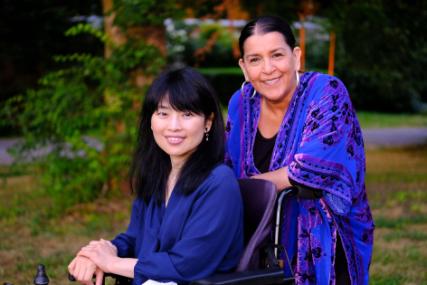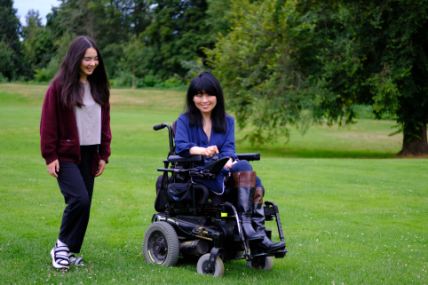Why place attachment is the most important idea to combat isolation and build resilience

New Addition During the Pandemic: My daughter is sitting on the swing attached to a big tree branch in a nearby park. The swing was constructed and placed by my neighbour during the pandemic. Aug 2, 2020. Photo credit: Alistair Eagle
By Keiko Honda
It is not a coincidence that during the lockdown in the face of the pandemic, most of us looked for new ways to maximize the functionality of our home space, then found ourselves feeling more independent, competent, and comforted, despite the challenge. As many activities are happening in our homes and proximity, we have invested our practices and developed an emotional sense of deep connection with particular places – a sense of “rootedness”. Place becomes an extension of the self. That’s called place attachment, the concept which scholars in environmental psychology, sociology, anthropology, and human geography consider an essential element in understanding identity, human well-being and sociality, memory formation, community participation, and environmental responsibility and advocacy for the environment.
“Place makes memories cohere in complex ways. People’s experiences of the urban landscape intertwine the sense of place and the politics of space,” says architectural historian Dolores Hayden. Similarly, psychologists postulate that we lock ideas and objects by linking them to a place: integrating many stimuli together helps us remember something particularly important, called episodic memories. This pandemic has disrupted our physical connections to many familiar social places like offices, cafes, schools, gyms, restaurants, community centres, movie theaters and many more, keeping almost everyone, especially seniors and those who are at higher risk of severe illness from COVID-19, at home for seemingly endless time (until the pandemic will come to an end). How does supposedly immobilized life imposed by the pandemic affect the way we store memories and the way we create meaning in our lives? What do large groups of people remember – and forget? It is an intriguing question for future historians. Social memory is at stake and thus deeply pertinent here. As reminded by WHO’s Healthy Ageing, being able to live in environments that support and maintain seniors’ mental and physical capacities is key to healthy aging and community.

A “family” portrait with my neighbour and friend, Debra Sparrow: We spontaneously call each other to meet up for a forest walk, as we both live very closeby. Aug, 2020. Photo credit: Alistair Eagle
That wisdom and teaching has long been practiced by many Indigenous communities. Indigenous wisdom holds that humans are related to every part of nature – not in abstract terms, but very personally. “We need fibers and fibers of life that have sustained us all of these thousands of years. When we destroy our environment, we are destroying ourselves,” says a renowned Salish weaver, Debra Sparrow. She continues, “Our ancestors were so intelligent. They went out to the environment and found dyes that were also medicine…..They got stinging nettles. You drank it to clean your blood, so you did not have to take penicillin.” The deep connections between the Coast Salish people and their physical surroundings are a powerful aspect of their life that informs their sense of identity, creates meaning in their lives, facilitates community and influences action toward environmental stewardship.
While place attachment is hypothesized to be strongly related to health, how it is related to health appears to be different for different groups. A studyof Māori and non-Māori in advance age in New Zealand found the positive associations among Māori between the importance of nature and the outdoors, place attachment (i.e., connectedness to neighbourhood and community) and health, whereas liking home and neighbourhood, place attachment and health were found to be linked among non-Māori. The most recent study of a large representative sample of Japanese nationals reveals that place attachment partially mediates the links between the natural environment and mental health, accounting 30 percent of the total effect of nature on mental health. While the places to which people develop attachment bonds may vary, one important message is that place attachment plays as an adaptive (or survival) strategy that sustains and improves our mental and physical health and may fight against social isolation and environmental challenges happening in their own places.

Rooted: My daughter and I often come to this park even before COVID, independently or jointly. After a short walk, I always find myself feeling renewed and calm. Aug, 2020. Photo credit: Alistair Eagle
It is not surprising that COVID provokes the breakage of attachment bonds with many familiar physical places at different levels – home, residential block, neighborhood, town/city level, or even broader level, particularly in cases of forced relocation or lockdown – that social isolation, especially among seniors, is already a public health crisis worldwide.
That brings us back to the question of what constitutes place attachment. What can we do to develop it for going forward, as some pandemic mitigation measures including social distancing may become permanent. In the context of a changing climate, a more complex geopolitical landscape, and a constant threat of pandemic all together, developing genuine emotional connections with physical places is a complicated, and yet urgent need. Are attachment to place and sense of rootedness only relevant to the well-being of people in old age? What about other ages? What about those displaced? What about those who are abused or neglected where they live? Will the benefits of place attachment withstand when other types of threats such as the psychological threats are present? What about climate change threatening our right to housing?
Is place attachment a crucial ability for human survival? The answer is still yes. What would our role – as a global citizen and a neighbour – mean, require, demand of us right now? What stories and memories will we pass on to our future generations?
Originally published at http://thecolloquiumsite.wordpress.com and at https://medium.com on August 28, 2020
Keiko Honda, Ph.D., MPH is a Director of the Kerrisdale Community Centre Society since 2010 and the Founder and Executive Director of the Vancouver Arts Colloquium Society. Keiko completed a Doctorate degree in Public Health in NYU and a post-doctoral fellowship in Cancer Epidemiology in Columbia University where she worked as a research scientist before she moved to Vancouver in 2009. She also teaches a course, Social Artistry Through Co-Creation at the SFU Continuing Studies.







The more people that successfully make their way to your site, the more visitors you will have actually reading your content. Alvinia Jerrie Gemoets
I think what you wrote made a great deal of sense. Lillis Roosevelt Fayina
Excellent post! We will be linking to this great post on our site. Keep up the great writing. Rona Griffin Jodee